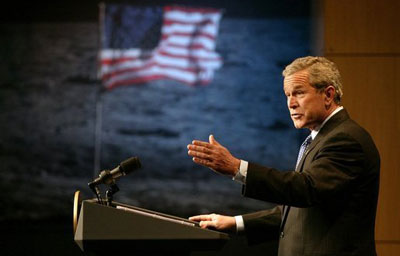Looking beyond visionby Jeff Foust
|
| This “trillion-dollar” adjective is interesting because not only does it have no apparent basis in fact, those who have used it have made little effort to defend its use. |
At the other extreme, the administration may have unintentionally confused a number of people when Bush stated that he would add $1 billion to NASA’s budget over the next five years. That seemed a far cry from earlier reports that suggested NASA would see budget increases of five percent a year over the next five years. Some pointed out that the increase—an average of $200 million a year—would be insufficient to compensate for inflation even at today’s modest rates.
However, that $1 billion is being added to a budget that already includes some modest increases. Prior to the new plan NASA was looking at a five-year budget plan that totaled $86 billion. Given the approximately $15.4 billion the agency gets in 2004, that plan already had factored into it an average annual growth rate of about 3.5 percent: enough to account for inflation plus a little bit extra. The new plan changes that to a five-percent growth rate for the first three years and then one percent for the following two, enough to eke out an additional billion over five years for the agency. That extra funding comes at a price: those two outyears—2008 and 2009—will get increases under the current plan that will likely be below the inflation rate (which was 1.9% in 2003), giving the agency, in essence, minor budget cuts in those years.
Plan farsightedness
Another interesting aspect of the plan is its farsightedness. If you went to someone familiar with space policy about six months ago and told him or her that, late this decade, the shuttle would be flying to complete the assembly of the ISS, unmanned test flights of a new crewed vehicle would be underway, and robotic missions would begin again to the Moon, that person might have well concluded that there had been no new space initiative. Bush’s plan is notable for its lack of significant near-future milestones.
| With few significant achievements over the next five years, it would be possible for Bush’s successor to redirect the program to different aims, including those that don’t include missions to the Moon or Mars, with little wasted money. |
Most of what NASA will accomplish between now and the end of the decade are projects that, in one form or another, the agency was planning to do anyway. The shuttle was going to return to flight and the station was going to be completed, one way or another. NASA was working on the Orbital Space Plane, which will likely morph into the CEV. And, although NASA had yet to commit to a robotic lunar mission, a sample-return mission to the Moon’s South Pole-Aitken Basin, rated highly by planetary scientists in a recent review, was one of four “strawman” missions being considered for NASA’s New Frontiers program later this decade. There will certainly be a lot of preparatory work for future missions, but that work will likely be behind the scenes, largely out of view of the public.
This approach raises some interesting possibilities and concerns. Five years from now—January 20, 2009, the end of a hypothetical second term for Bush—the shuttle will still be flying, the station will be in the final stages of assembly, and the CEV will be undergoing unmanned tests. With few significant achievements during that time, it certainly would be possible for Bush’s successor to redirect the program to different aims, including those that don’t include missions to the Moon or Mars, with little wasted money. (If Bush loses in November, his Democratic successor will almost likely junk the plan in favor of something else.) However, if Bush and NASA succeed in selling the plan to the American public, it could survive a change in administrations.
